The Shrine of Our Lady of Madhu, Mannar, Sri Lanka is a Roman Catholic shrine in the Mannar district of Sri Lanka. Madhu Church has been a place of adoration for people of all faiths and walks of life as a center for pilgrimage and worship for Sri Lankan Catholics. Nestled amidst acres of tall green trees in the thick Mannar jungle, dedicated to the Blessed Virgin Mary, mother of Jesus. Madhu church has been long considered the holiest Catholic shrine in Sri Lanka. Madhu Palliya is regarded as a symbol of unity and peace among all the diverse ethnicities on these holy grounds.
Madu Church at Mannar, which Catholics believe to be a shrine of miraculous healing power, has bestowed blessings on thousands of people for centuries. All year long, Mother Mary’s life is celebrated here, but the grandest celebration of all is held in August, which coincides with the Feast of Mother Mary’s Assumption to Heaven, which attracts large crowds of Catholic devotees from all over the island to the church premises. History has shown that the shrine could widen ethnic harmony and unity in Sri Lanka with certainty.
Our Lady of Madhu Church at Mannar has been a symbol of unity not just between the Sinhalese and Tamils but also between the people of different religions. In 2015, his Holiness Pope Francis set foot on this hallowed soil, which is revered by many as the dwelling place of divine presence on Sri Lankan soil, and opened the Blessed Sacrament Chapel during his holiness’s visit. The statue of Our Lady of Madhu had been taken for procession three times to the parishes in Sri Lanka, in 1948, 1974, and 2001. This church in the rural Mannar District is a profound religious site of great spirituality and divinity, wrapped in peaceful tranquility.
The Shrine of Our Lady of Madhu survived the dark stages of the war in Sri Lanka, and today the shrine stands humbly in the realm of spiritual victory. As we look back over time, the church and the faith of her congregation were tested in the furnace of adversity. Amidst the present pilgrimage of this holy ground, one must remember that this church in the wilderness of Mannar has withstood the victories and vicissitudes of life, just as the Christian life itself is indeed a mix of trial and triumph. This shrine symbolizes our need for God and our ability to accept and appreciate people from diverse cultures and religions.
Madhu Church was also seen as a symbol of reconciliation, justice, and peace, playing a significant role as a safe zone during two intense periods of war in Sri Lanka. Hundreds of Hindus and Catholics came and lived around the outer perimeter of the church. This Catholic Church of Sri Lanka stood as a caring center for these displaced civilians in their darkest hour amidst conflict. In the shadow of this holy shrine, these weary people found comfort, and many families returned every year with hearts of immense gratitude to Jesus Christ.
The country’s brutal civil war ended on May 18, 2009. Since 2010, the feast and mass have drawn thousands of devout Catholics. With a history spanning over 400 years, the Madu Church festival is celebrated annually on July 2nd and August 15th.
Shrine of Our Lady of Madhu Contact number: 0232 280 001
Related Post: St. Anne’s Shrine, Thalawila, Sri Lanka
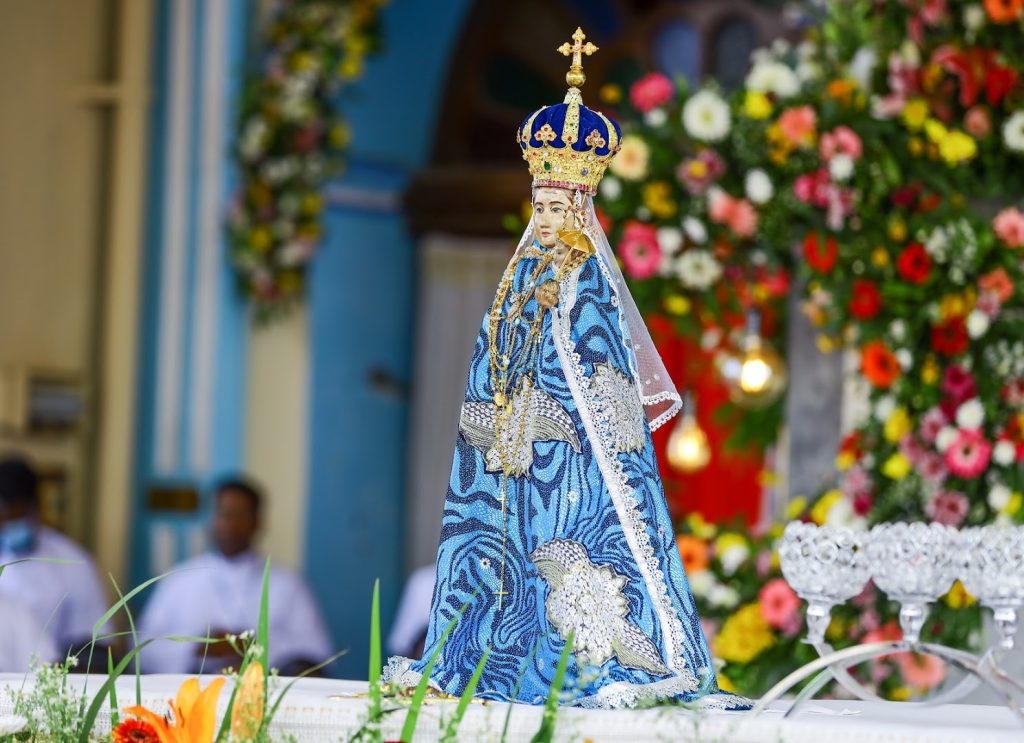
100th Year Crowning Celebration [1924 -2024]



History of Madhu Church
A sanctuary of miraculous healing, where faith ignites hope…
The Shrine of Our Lady of Madhu is regarded as the holiest Catholic shrine in Sri Lanka, possessing a history that goes back more than 400 years.
In the 16th century, Portuguese missionaries from India, especially under the authority of Saint Francis Xavier, introduced Roman Catholicism to the Kingdom of Jaffna in northern Sri Lanka. In 1544, the newly converted 600–700 Christians were persecuted by Cankili, the king of Jaffna. During this time, the Catholics regrouped to form a church a few miles north in Manthai, installing a statue of Our Lady of Mother there.
The miraculous statue of Mother Mary holding the infant Jesus at its altar has an intriguing history, and much of its past has been lost with time. The initial abode of Our Lady of Madhu is said to have been in Mantai, situated a short distance away from its present place.
In the 17th century, when the Dutch invaded Sri Lanka and the persecution of the Catholic Church began in 1670, 20 Catholic families fled from their homes in the coastal town of Manthai. Despite their haste to escape, they carried the statue of Mary from their local church with them. Under the protection of the Heavenly Mother, the little company of twenty devoted families wandered in the thick forest of the Wanni in constant fear of the enemy.
Guided by divine Providence, they reached a hamlet called Maruthamadhu by the side of an ancient tank on the royal Rameswaram-Kandy route, where there was a customs house belonging to the Kandyan king. In the calm and serene atmosphere of Maruthamadhu, the seed of Catholicism grew under Our Lady’s protection, while persecution raged throughout Jaffna.
Meanwhile, there was another movement towards Madhu from the Jaffna Peninsula. To avoid the Dutch persecution, about 700 Catholics migrated south from Jaffna into the Vanni forests. Having wandered for days in anxiety and fear, they too, as if guided by a miracle, were led to Maruthamadhu. The two communities came across each other in Madhu, where they decided to build a small shrine from clay for the statue of Mary. According to the annals of history, a woman named Helena is said to have been instrumental in building the first church in Madhu.
One of the Catholics who arrived recently was the daughter of a Portuguese captain, named Helena. Over time, she married the officer in charge of the nearby custom house belonging to the Kandyan kings in Madhu. This pious lady, Helena, gave leadership to fellow Catholics and built the first church dedicated to Our Lady of Madhu. In grateful remembrance of her pioneering efforts, the Christians have immortalized her memory by calling the place “Silena-Marutha-Madhu,” which to the present day continues to be one of the names of the holy sanctuary. Over time, this small church developed into a major pilgrimage destination and place of worship for devotees across the country.
With the revival of the Catholic faith by missionaries such as Joseph Vaz, the small shrine was expanded in the late 17th century. With the arrival of the British on the island, anti-Catholic persecution came to an end, and the shrine at Madhu began attracting pilgrims from all over the country. The church that stands today was initiated by Bishop Bonjean in 1872, and his successors built a facade, a spacious presbytery, a restful chapel of the Blessed Sacrament, and a grotto of Our Lady of Lourdes.
In the year 1870, Bishop Bonjean arranged an annual feast to be celebrated on the 2nd of July. But in recent years, the August 15th feast has drawn the biggest crowds because it is one of the most hallowed days for Catholics celebrating the Assumption of the Blessed Virgin Mary into heaven and also because the school holidays facilitate entire families making the trip.
The Coronation Ceremony of Madu Church
In 1870, 200 years after the original 20 families fled Mantai, the first stone of the present church was laid by Bishop Bonjean. In 1924, the statue of Our Lady of Madhu was officially crowned by Pope Pius XI. The solemn canonical coronation ceremony at the Shrine of Our Lady of Madhu witnessed two gem-studded golden crowns adorning the brows of Mother Mary and the head of Infant Jesus. In 1944, the formal consecration ceremony of the church took place.
What is the Madhu Festival Season?
In the liturgical calendar of the Catholic Church, five main feasts mark key milestones in Mother Mary’s life. March 25 is the Annunciation of the Lord when the Angel Gabriel met Mary. July 2nd is Visitation Day, where Mary met Elizabeth, mother of John the Baptist. August 15 was the Assumption when she entered heaven. September 8th is her birthday. December 8 is the Day of Immaculate Conception. Out of these, the August 15 feast became the most popular, and the period is known as the Madhu season.
Every year in August, the tranquil town of Madu witnesses the arrival of hundreds of thousands of Roman Catholics from all parts of Sri Lanka to celebrate the annual Feast of the Assumption. Although the church celebrates several festivals throughout the year, the Madhu Festival in August is probably the most important Catholic event, drawing hundreds of faithful devotees from all parts of the island. Although the church celebrates several festivals throughout the year, the Madhu Festival in August is probably the most important Catholic event.
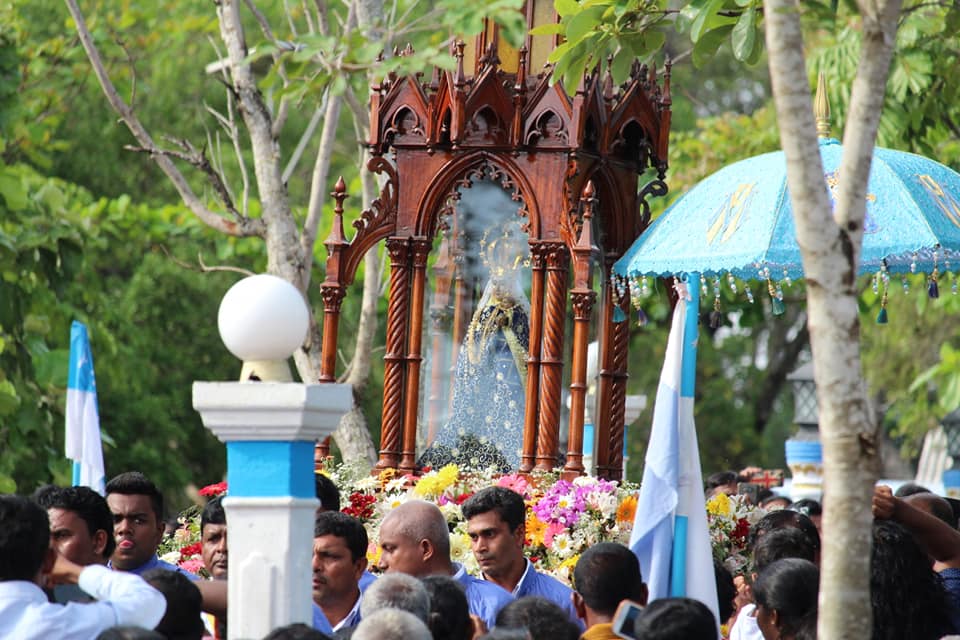
Feast Day of Shrine of Our Lady of Madhu
The annual feast of The Shrine of Our Lady of Madhu is celebrated on a grand scale in the month of August.
The Madhu Church celebrates many feasts, but the two most important ones are the Feast of Visitation, which falls on July 2, and the Feast of Assumption, which is held on August 15. The Feast of Assumption will take place from August 6 to August 15. The flag hoisting on August 6 starts the nine-day preparatory period before the feast of the Assumption of Mother Mary, on August 15.
It draws thousands of faithful devotees from all parts of the island to this 450-acre Shrine in the Jungle. Many come to pray and seek the succour of the Blessed Mother Mary for a miracle; for the Madhu Church is also known for its miraculous healing powers and many are the miracles duly recorded. The most commonly known are the miraculous healing powers of the statue, which can cure many diseases. The feast celebrations continue for up to ten days, with food, garments, cutlery, and many more vendors entertaining the crowds.
Camping in the church grounds is a ritual and a time-honoured tradition of the Madhu pilgrimage. Some will set up tents, while others will reside in small houses, which is an alternative to camping. The miraculous statue of Our Lady of Madhu has been offering solace, blessings, and refuge for years to the faithful who come to experience her divine presence. For its devotees, this shrine nestled amidst a dense jungle, is the ultimate safe haven and a beacon of hope and faith. Even after the annual feast concludes, crowds gather in throngs all year, seeking the holy mother’s blessings.
The statue of the Virgin Mary is carried on the shoulders of her followers in and around the Church premises in an immense procession. Throughout this procession, devotees can be heard reciting the Rosary and singing hymns. The festivities conclude as the procession returns the Virgin Mary’s statue back to her home at Madhu Church. This blessed Shrine of Our Lady of Madhu has truly remained faithful to her calling as a spiritual beacon to the people who flock here seeking divine solace.
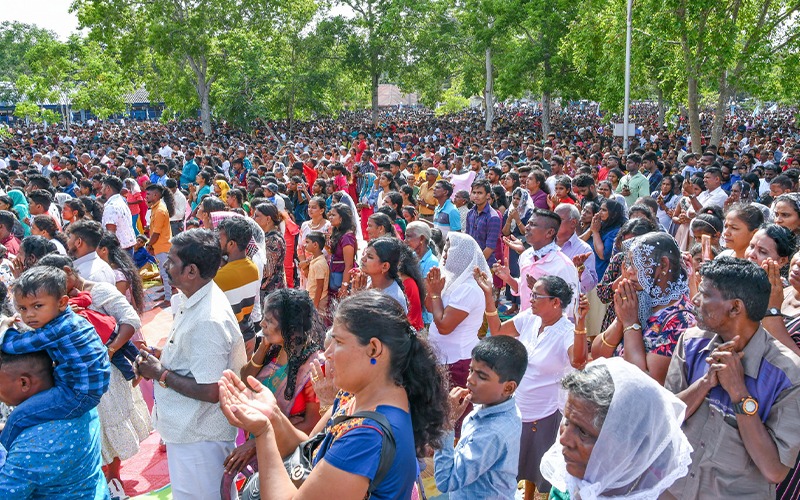
Madhu Church Mass Schedule
The Feast of The Shrine of Our Lady of Madhu attracts large crowds as it honors the day of the Assumption of Mother Mary into heaven.
Daily Masses:
Monday to Friday: 06:00 am – in Tamil | 6.45 am – in Sinhala
Saturday and Sunday: 06:00 am – in Tamil | 6.45 am – in Sinhala | 11.45 am – in Tamil and Sinhala
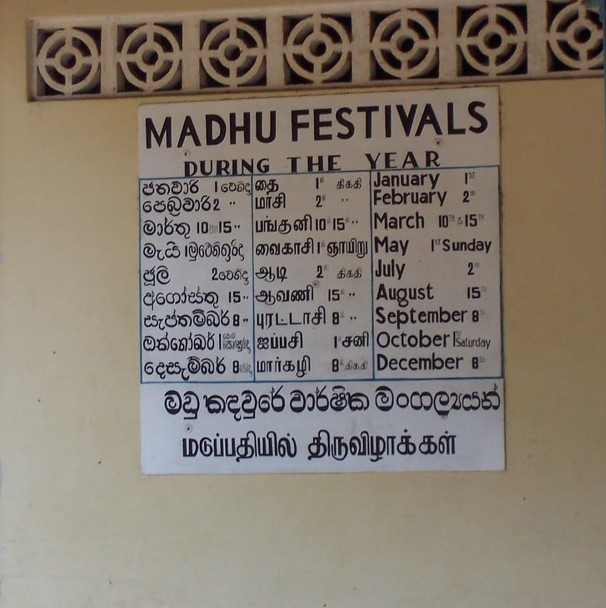
How to reach the Madhu Church?
The Madhu Church is situated almost 300 km away from Colombo. Travel from Madawachchiya along Thalaimannar on Madawachchiya Road (A14) to Madhu Junction, then take Madhu Road (B 378) to Madhu Church.
Address: Shrine of Our Lady of Madu, Puliyadi Irakkamam, Madhu Road, Mannar-41000, Sri Lanka.
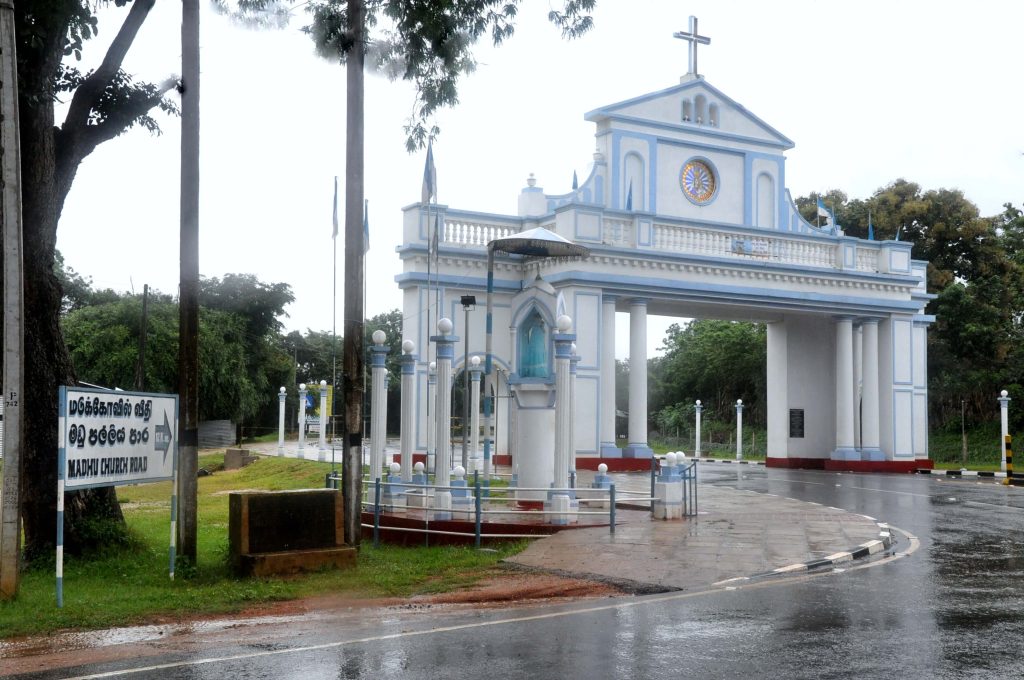
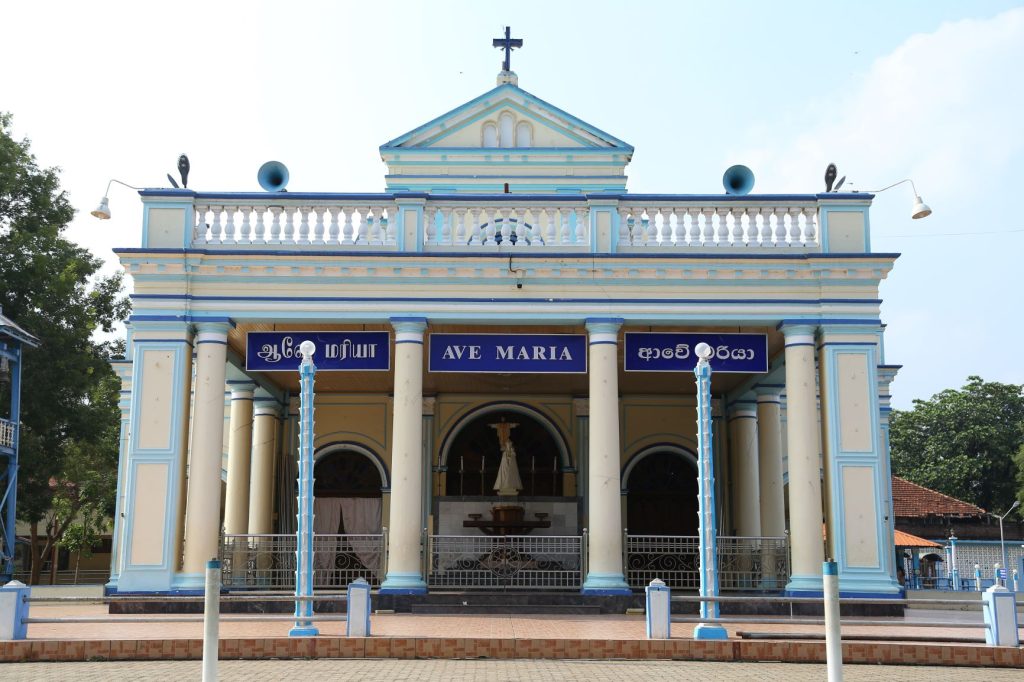
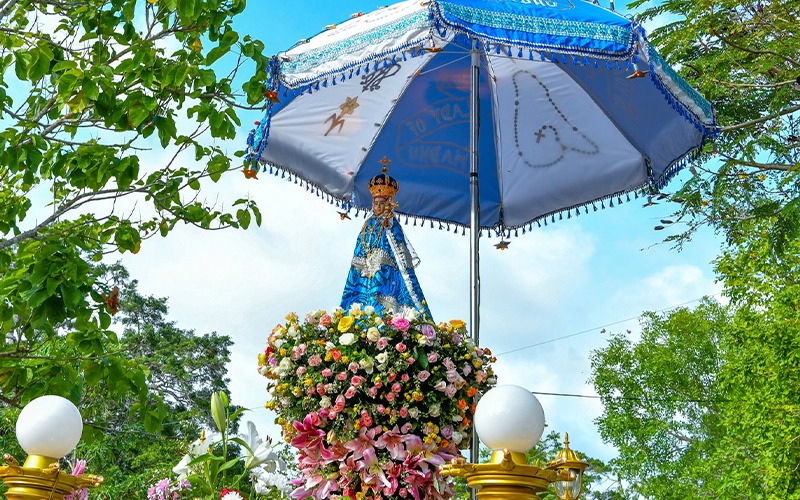

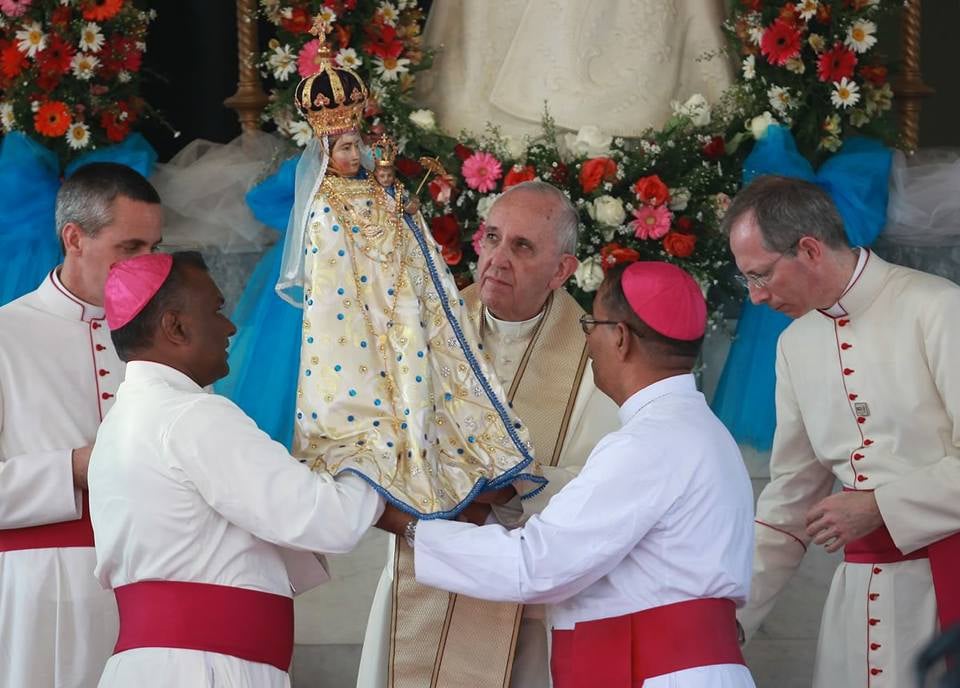
The Hail Mary
Hail, Mary, full of grace,
the Lord is with thee.
Blessed art thou amongst women
and blessed is the fruit of thy womb, Jesus.
Holy Mary, Mother of God,
pray for us sinners,
now and at the hour of our death.
Amen.
Reference(s): Wikipedia | dailynews.lk | sundaytimes.lk
Affiliate Disclosure: As an Amazon Associate, I earn from qualifying purchases. This blog post may contain other affiliate links as well by which I earn commissions at no extra cost to you.

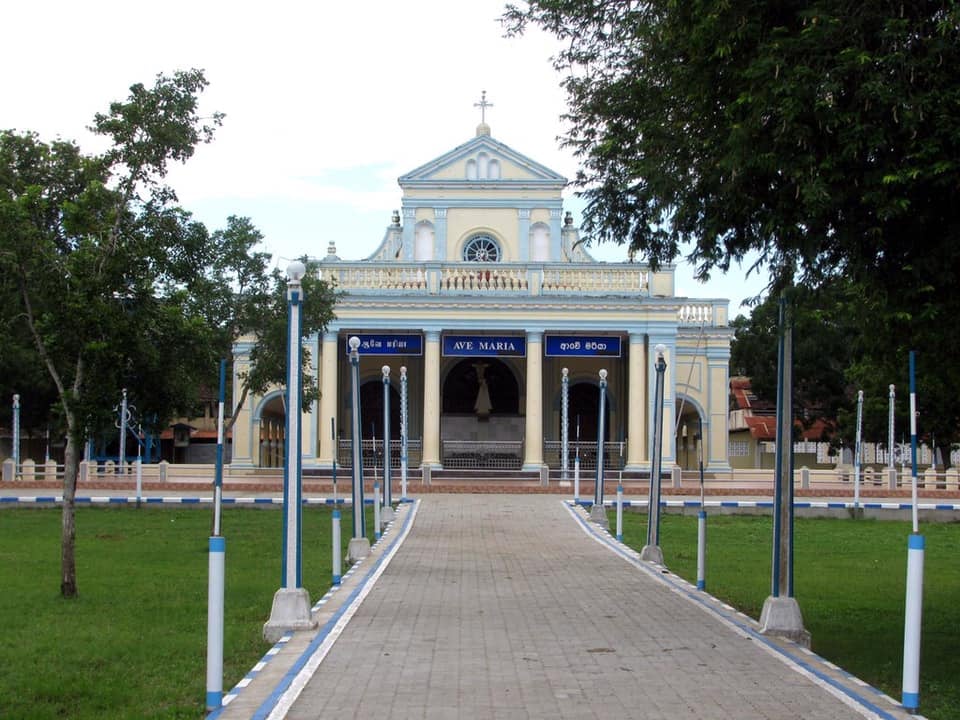
What a fantastic resource! The articles are meticulously crafted, offering a perfect balance of depth and accessibility. I always walk away having gained new understanding. My sincere appreciation to the team behind this outstanding website.
” Highly appreciate your positive feedback. Thank you. “
Hello mates, how is all, and what you wish for to say concerning this
piece of writing, in my view its truly amazing designed for me.
Wow, awesome blog layout! How long have you been blogging for?
you make blogging look easy. The overall look
of your site is fantastic, let alone the content!
This piece of writing will assist the internet viewers for setting up
new blog or even a weblog from start to end.
Hey I know this is off topic but I was wondering if you knew
of any widgets I could add to my blog that automatically
tweet my newest twitter updates. I’ve been looking for a plug-in like this for quite some time and was hoping maybe you would have some
experience with something like this. Please let me know if you run into anything.
I truly enjoy reading your blog and I look forward to your
new updates.
Hi to all, how is the whole thing, I think every one is getting more from this web site, and your views are good in support of
new visitors.
” Happy to hear that. Thank you. “
Hello there! This post could not be written any better!
Reading this post reminds me of my good old room mate!
He always kept chatting about this. I will forward this page to him.
Pretty sure he will have a good read. Thanks for sharing!
I like reading an article that can make people think. Also,
thank you for allowing for me to comment!
Thank you for another informative website. Where else may just
I am getting that type of info written in such a perfect manner?
I have a project that I am simply now working on, and I have been on the glance out for
such information.
Hello There. I found your blog using msn. This is a really well
written article. I’ll be sure to bookmark it and return to read more of your useful information. Thanks for the post.
I’ll certainly comeback.
Hey there! I’ve been following your website for a long time
now and finally got the courage to go ahead
and give you a shout out from Dallas Texas! Just
wanted to mention keep up the excellent work!
We absolutely love your blog and find many of your post’s to be exactly what I’m looking for.
Do you offer guest writers to write content for yourself?
I wouldn’t mind writing a post or elaborating on a number of
the subjects you write with regards to here.
Again, awesome web log!
Wonderful article! That is the kind of information that
are supposed to be shared around the net. Shame on the search engines for now not positioning this submit higher!
Come on over and seek advice from my web site
. Thank you =)
Yes! Finally someone writes about have a peek at this web-site.
Heya i’m for the first time here. I found
this board and I find It truly useful & it helped me out much.
I hope to give something back and help others like you helped me.
Great blog you’ve got here.. It’s hard to find good
quality writing like yours nowadays. I really appreciate individuals like you!
Take care!!
Oh my goodness! Amazing article dude! Thank you, However I am encountering troubles with your RSS.
I don’t understand why I am unable to subscribe to it.
Is there anybody else getting the same RSS problems? Anyone who knows the answer can you kindly respond?
Thanks!!
That is really interesting, You’re an overly professional blogger.
I’ve joined your feed and look ahead to in the hunt for extra of your excellent post.
Additionally, I’ve shared your site in my social
networks
” Highly appreciate your feedback. Thank you.”
Asking questions are genuinely pleasant thing if you are not understanding something totally, however this post offers good understanding yet.
Now I am ready to do my breakfast, later than having my breakfast coming over
again to read more news.
Thanks for ones marvelous posting! I definitely enjoyed reading it, you can be
a great author.I will ensure that I bookmark your blog and will
eventually come back later in life. I want to encourage that you continue your great work,
have a nice morning!
An impressive share! I’ve just forwarded this onto a co-worker who has been doing a little homework on this.
And he actually ordered me dinner because
I found it for him… lol. So let me reword this….
Thank YOU for the meal!! But yeah, thanx for spending
some time to discuss this issue here on your web site.
At this time it looks like WordPress is the top blogging platform out there right now.
(from what I’ve read) Is that what you are using on your blog?
Good blog! I really love how it is easy on my eyes and the data are well written. I’m wondering how I might be notified when a new post has been made. I have subscribed to your RSS feed which must do the trick! Have a nice day!